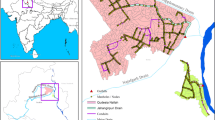Abstract
Hydrological Simulation Program Fortan (HSPF) is a mathematical modelling program developed by the United States Environmental Protection Agency (EPA). HSPF is used for simulating of watershed hidrology and water quality. In this paper, an evolutionary algorithm is applied to automated watershed model calibration. The calibration stage of the model is very important in order to reduce the errors in hydrological predictions. Results show the capacity of the proposed method to simulate watershed streamflows.
Funded by projects CICYT TSI2005-07344, CICYT TEC2005-07186 and CAM MADRINET S-0505/TIC/0255.
Preview
Unable to display preview. Download preview PDF.
Similar content being viewed by others
References
Singh, V.P., Woolhiser, D.A.: Mathematical modeling of watershed hydrology. Journal of Hydrologic Engineering 7(4), 270–292 (2002)
Singh, V.P.: Environmental Hydrology. Kluwer Academic, Borton (1995)
Bricknell, B.R., Imhoff, J.C., Kittle, J.L. Donigian Jr., A.S., Johanson, R.C.: Hydrological Simulation Program - Fortran. User’s Manual for Realese 11. EPA-600/R-97-080, USEPA, Athens, GA, p. 755 (1997)
Jacomino, V.M.F., Fields, D.E.: A critical approach to the calibration of a watershed model. J. Am. Water Resour. Assoc. 33, 143–154 (1997)
Liong, S.Y., Van Nguyen, V.T., Gautam, T.R., Wee, L.: Alternative well calibrated rainfall-runoff model: genetic programming scheme. Paper presented at World Water and Environmental Resources Congress 2001 (papers on CD-ROM), May 20-24 2001, Orlando, Florida, USA (2001)
Crawford, H.H., Linsley, R.K.: Digital Simulation in Hydrology: Stanford Watershed Model IV. Technical Report No. 39, Dept. of Civil Eng., Stanford University, Stanford, CA (1966)
Srinivasan, M.S., Hamlett, J.M., Day, R.L., Sams, J.I., Peterson, G.W.: Hydrologic modeling of two glaciated watersheds in northeast Pennsylvania. J. Am. Water Resour. Assoc. 34, 963–978 (1998)
Zarriello, P.J., Ries III, K.G.: A Precipitation-Runoff Model for Analysis of the Effects of Water Withdrawals on Streamflow, Ipswich River Basin, Massachusetts. USGS Water Resources Investigations Report 00-4029. p. 99 (2000)
Fontaine, T.A., Jacomino, V.M.F.: Sensitivity analysis of simulated contaminated sediment transport. J. Am. Water Resour. Assoc. 33, 313–326 (1997)
Laroche, A.M., Gallichand, J., Lagace, R., Pesant, A.: Simulating atrazine transport with HSPF in a agricultural watershed. ASCE J. Environ. Wngng. 122, 622–630 (1996)
Donigian Jr., A.S., Chinnaswamy, R.V., Jobes, T.H.: Conceptual Design of Multipurpose Detention Facilities for flood protection and Nonpoint Source Pollution Control, Aqua Terra Consultants, Mountain View, CA, 151 p (1997)
Goldberg, D.E.: Genetic algorithm in search, optimization, and machine learning. Addison-Wesley, Reading (1989)
Wang, Q.J.: The Genetic Algorithm and its Application to Calibrating Conceptual Rainfall-Runoff Models. Water Resour. Res. 27(9), 2467–2471 (1991)
Moyer, D.L., Hyer, K.E.: Use of Hydrological Simulation Program - Fortran and Bacterial Source Tracking for Development of the Fecal Coliform Total Maximum Daily Load (TMDL) for Blacks Run, Rockingham Country, Virginia. U.S. Geological Survey. Water Resources Investigations Report 03-4161. 2003.
Donigian Jr., A.S., Imhoff, J.C., Kittle Jr., J.L.: HSPFParm - An interactive database of HSPF model parameters, Version 1.0. EPA-823-R-99-004, USEPA, Washington, DC, p. 40 (1999)
Kamali, M., Ponnambalam, K., Soulis, E.D.: Hydrologic model Calibration using Fuzzy TSK surrogate model. In: NAFIPS 2005, Annual Meeting of the North American Fuzzy Inf. Proc. Soc (2005)
Author information
Authors and Affiliations
Editor information
Editors and Affiliations
Rights and permissions
Copyright information
© 2006 Springer-Verlag Berlin Heidelberg
About this paper
Cite this paper
Castanedo, F., Patricio, M.A., Molina, J.M. (2006). Evolutionary Computation Technique Applied to HSPF Model Calibration of a Spanish Watershed. In: Corchado, E., Yin, H., Botti, V., Fyfe, C. (eds) Intelligent Data Engineering and Automated Learning – IDEAL 2006. IDEAL 2006. Lecture Notes in Computer Science, vol 4224. Springer, Berlin, Heidelberg. https://doi.org/10.1007/11875581_26
Download citation
DOI: https://doi.org/10.1007/11875581_26
Publisher Name: Springer, Berlin, Heidelberg
Print ISBN: 978-3-540-45485-4
Online ISBN: 978-3-540-45487-8
eBook Packages: Computer ScienceComputer Science (R0)




